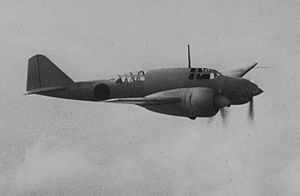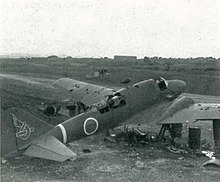Mitsubishi Ki-46
| Ki-46 | |
|---|---|

| |
| A Mitsubishi Ki-46-II "Dinah" of the Shimoshizu Army Flying School in flight. | |
| Role | Twin-engine reconnaissance aircraft |
| Manufacturer | Mitsubishi Aircraft Company |
| First flight | November 1939 |
| Introduction | July 1941 |
| Retired | September 1945 |
| Primary user | Imperial Japanese Army Air Force
|
| Number built | 1,742 |
The Mitsubishi Ki-46 was a twin-engine reconnaissance aircraft that was used by the Imperial Japanese Army in World War II. Its Army Shiki designation was Type 100 Command Reconnaissance Aircraft (一〇〇式司令部偵察機); the Allied brevity code name was "Dinah".
Development and design
On 12 December 1937, the
The resulting design was a twin-engined, low-winged
The first prototype aircraft, with the
To solve the performance problems, Mitsubishi fitted
Although at first the Ki-46 proved almost immune from interception, the Imperial Japanese Army Air Force realised that improved
In an attempt to yet further improve the altitude performance of the Ki-46, two prototypes were fitted with exhaust driven turbosupercharged Ha-112-II-Ru engines. This version first flew in February 1944, but only two prototypes were built.[10]
Mitsubishi factories made a total of 1,742 examples of all versions (34 units Ki-46-I, 1093 units Ki-46-II, 613 units Ki-46-III, 4 units Ki-46-IV) during 1941–44.[11]
Operational history

This aircraft was first used by the Japanese Army in
The

In 1944–45, during the last days of the war, it was modified as a high-altitude
The Ki-46 was also assigned to two whole
The Allies captured some examples during the conflict, which were then repaired and flown for evaluation purposes. The Ki-46 III was the only Japanese aircraft type sent to the NII VVS Soviet Air Force Test Institute, for evaluation during 1946–7.[13]
Variants
(note:- The Shiki designations must be used in full, as written below, because the Type number only refers to the year of the designs inception.)
- Army Type 100 Command Reconnaissance Plane
- The Shiki designation for the Ki-46 Command Reconnaissance Plane
- Army Type 100 Air Defence Fighter
- The Shiki designation for the Ki-46 Interceptor Fighter
- Army Type 100 Assault Plane
- The Shiki designation for the Ki-46 Assault Plane
- Ki-46
- Prototype.
- Ki-46 I
- Reconnaissance version of the Ki-46.
- Ki-46 II
- The first operational model of the series.
- Ki-46 II KAI
- Three-seat training version of the Ki-46. Used for radio and navigation training, with a redesigned cabin, dorsal en echelon extension. Conversions of the Ki-46 II.
- Ki-46 III
- "Traditional" stepped windshield replaced with a smooth, curved, glazed panel extended over the pilot's seat giving a more aerodynamic nose profile. Engine power increased to 1,500 hp (Ha-112-II), extra fuel tank added in the nose.
- Ki-46 III-KAI
- Defense interceptor/night fighter version of the Ki-46. Equipped with two 20 mm cannon in the nose and one 37 mm (1.46 in) cannon in the "Schräge Musik"-style upwards-aimed dorsal frontal position.
- Ki-46 III
- Land strike version of the Ki-46, without 37 mm (1.46 in) cannon armament.
- Ki-46 IIIb
- Ground-attackversion.
- Ki-46 IIIc
- Unbuilt design project.
- Ki-46 IV
- Prototype, equipped with two turbocharged 1,119 kW (1,500 hp) Mitsubishi Ha-112-IIru engines, and more fuel capacity.
- Ki-46 IVa/b
- Series models of reconnaissance/fighter aircraft, unbuilt design projects
Operators
- French Air Force– Captured aircraft.
- Imperial Japanese Army Air Force
- Imperial Japanese Navy Air Service
- Chinese Communist Air ForceTwo captured Ki-46s in communist Chinese hands served as a ground-attack aircraft and a trainer respectively, and the last Ki-46 retired in the early 1950s.
Surviving aircraft

The only known survivor is a Ki-46-III Army Type 100 example, that is part of the collection of the Royal Air Force Museum in the United Kingdom. Built around 1943, it was part of the 81st Sentai, 3rd Chutai IJAAF. This unit had detachments deployed across the South West Pacific.[14]
In late 1945, Japanese Surrendered Personnel at Kuruan Airfield in British Malaya were ordered to restore two Ki-46's at the base to airworthy condition for the Allied Technical Air Intelligence Unit. They managed this with one aircraft, and it was flown to Seletar, Singapore by a Japanese pilot in early 1946. It made a number of flights with Japanese pilots and was selected for museum preservation. It was shipped to the United Kingdom in mid-1946.[14]
It became part of the
Specifications (Ki-46-II)

Data from Japanese Aircraft of the Pacific War[16]
General characteristics
- Crew: 2
- Length: 11 m (36 ft 1 in)
- Wingspan: 14.7 m (48 ft 3 in)
- Height: 3.88 m (12 ft 9 in)
- Wing area: 32 m2 (340 sq ft)
- Empty weight: 3,263 kg (7,194 lb)
- Gross weight: 5,050 kg (11,133 lb)
- Max takeoff weight: 5,800 kg (12,787 lb)
- Powerplant: 2 × Mitsubishi Ha-102(Army Type 100 1,050hp Air Cooled Radial) 14-cylinder air-cooled radial piston engines, 810 kW (1,080 hp) each for take-off
- 787 kW (1,055 hp) at 2,800 m (9,200 ft)
- Propellers: 3-bladed constant-speed metal propellers
Performance
- Maximum speed: 604 km/h (375 mph, 326 kn) at 5,800 m (19,000 ft)
- Cruise speed: 400 km/h (250 mph, 220 kn) at 4,000 m (13,000 ft)
- Range: 2,474 km (1,537 mi, 1,336 nmi)
- Service ceiling: 10,720 m (35,170 ft)
- Time to altitude: 8,000 m (26,000 ft) in 17 minutes 58 seconds
Armament
- Guns: 1× 7.7 mm (0.303 in) Type 89 machine gun flexibly mounted in the rear cockpit (not fitted to all models)
See also
Aircraft of comparable role, configuration, and era
- Nakajima C6N Saiun, the single-engine IJN equivalent, fastest Japanese carrier-based aircraft of the war
- de Havilland Mosquito
- Douglas P-70/F-3 Havoc
- Junkers Ju 88
- Kawasaki Ki-45
- Lockheed P-38
- Messerschmitt Me 410Hornisse
- Nakajima J1N Gekko
- Petlyakov Pe-3
- Tachikawa Ki-70
- Tupolev Tu-2
Related lists
Notes
- ^ a b Air International November 1980, p. 227.
- ^ a b Francillon 1979, pp. 169–170.
- ^ Francillon 1979, p. 170.
- ^ Air International November 1980, p. 230.
- ^ Francillon 1979, pp. 170–171.
- ^ Francillon 1979, p. 172.
- ^ Air International November 1980, pp. 231–232.
- ^ Francillon 1970, p. 257.
- ^ Ferkl 2005, p. 7.
- ^ Air International November 1980, p. 232.
- ^ Francillon 1979, p. 176.
- ^ Thomas, Andrew Making the Best Better article Fly Past magazine February 2006 pp92-4
- ^ Kotelnikov, V. Stalin's Captives article in Fly Past magazine, February 2017 p.106 with ground photo
- ^ a b c Andrew Simpson (2012), Mitsubishi Ki-46-III 'Dinah' BAPC. 84/8484M Museum Accession Number 1989/0307/AF (PDF), RAF Museum, retrieved 22 Nov 2013
- ^ "Rare Japanese WW2 types moved to London". www.key.aero. 2022-10-31. Retrieved 2024-03-06.
- ^ Francillon 1979, pp. 176–177.
Bibliography
- Ferkl, Martin (2005), Mitsubishi Ki-46 Dinah, Ostrava-Poruba, Czech Republic: Revi Publications, ISBN 9-788085-957112, No. II-4002
- Francillon, Réne J. (1966), The Mitsubishi Ki-46 (2nd ed.), Leatherhead: Profile Publications
- Francillon, René J. (1970), Japanese Aircraft of the Pacific War, London: Putnam, ISBN 0-370-00033-1
- Francillon, René J. (1979), Japanese Aircraft of the Pacific War (2nd ed.), London: Putnam & Company, ISBN 0-370-30251-6.
- Green, William (1961), Warplanes of the Second World War, Volume Three: Fighters, London: Macdonald & Co. (Publishers), ISBN 0-356-01447-9.
- Gunston, Bill (1978), The Illustrated Encyclopedia of Combat Aircraft of World War II, London: Salamander Books, ISBN 0-89673-000-X
- Millot, Bernard (February 1977). "Mitsubishi Type 100 Ki.46 Shin Shitei "Dinah" (1)". Le Fana de l'Aviation (in French) (87): 22–27. ISSN 0757-4169.
- "Mitsubishi Ki. 46...the Aesthetic Asiatic". ISSN 0306-5634.
- Soumille, Jean-Claude (September 1999). "Les avions japonais aux coleurs françaises" [Japanese Aircraft in French Colors]. Avions: Toute l'Aéronautique et Son Histoire (in French) (78): 6–17. ISSN 1243-8650.
